Creating a customer journey map is vital for any business to optimize its sales and marketing processes.
According to Salesforce, “among high-performing teams, 88% say a customer journey strategy is critical to the success of their overall marketing.”
An effective customer journey map will include each customer touchpoint a shopper interacts with on the way to making a purchase.
If you’re looking to create this document from scratch or looking for ways to improve your map, below are some customer journey map examples from highly successful companies.
Customer Journey Map Examples
When doing customer journey mapping, you should think deeply about your business and the customer experience. On that note, let’s dive into some real-life customer journey mapping and walk you through what makes customer journey maps so valuable.
Consumer SaaS Customer Journey Map Examples
Customer journey maps are essential to B2C companies in the SaaS space. It can be expensive to acquire a new customer and each month that you’re able to keep a subscription active deepens your ROI and ROAS.
Understanding each customer interaction, pain points and customer needs is vital for maximizing value throughout the customer lifecycle - and a user journey map will help identify these areas.
1. Spotify
Spotify is one of the world’s most popular audio streaming services. When Spotify wanted to improve the music-sharing experience for its customers, it hired a marketing firm to create a customer journey map.
The goal of this user journey map was to determine where music sharing features the best fit into the customer experience.
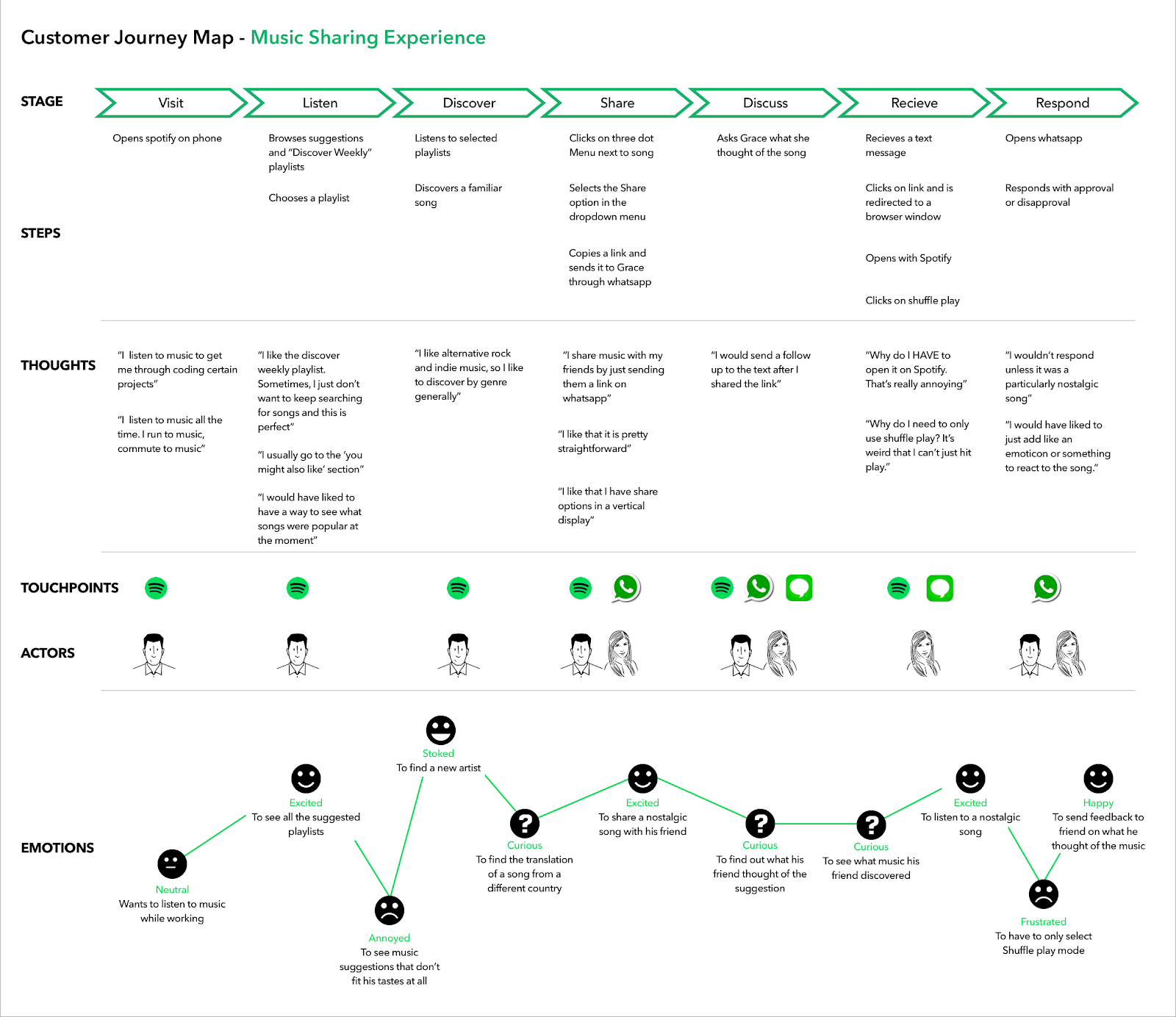
In this example, we see the user experience mapped out from the moment the user first opens Spotify on a mobile device, all the way through to whether they like a song that a friend has shared.
Also Read: Effective Customer Journey Design
Throughout each stage and every touchpoint, the brand lists what a customer is engaging with, doing, thinking, and feeling (something that's commonly done with an empathy map). The agency used data research and customer surveys to better understand how users felt at each touchpoint in the customer journey to collect this information.
Based on the customer journey map, Spotify was able to identify pain points for users and address those pain points so that the music sharing experience is smooth and seamless, encouraging more users to share music -- and to do it more often. \
This journey map is excellent because it identifies key areas of customer engagement, takes into account customer behavior, and has the goal of making the customer experience as enjoyable as possible.
The end result is significantly higher customer satisfaction, which can have several key benefits, including a smoother buyer journey, greater customer loyalty, and in many cases, existing customers becoming brand advocates.
2. TurboTax
Turbo Tax is a leading online software package for preparing taxes. When the TurboTax team was ready to launch a new product called Personal Pro, they created a customer journey map to better understand the overall customer experience with this new product.
The team used a mix of data research, customer surveys, and key conversations with tax professionals to understand how the product fits into the lives of those using it.
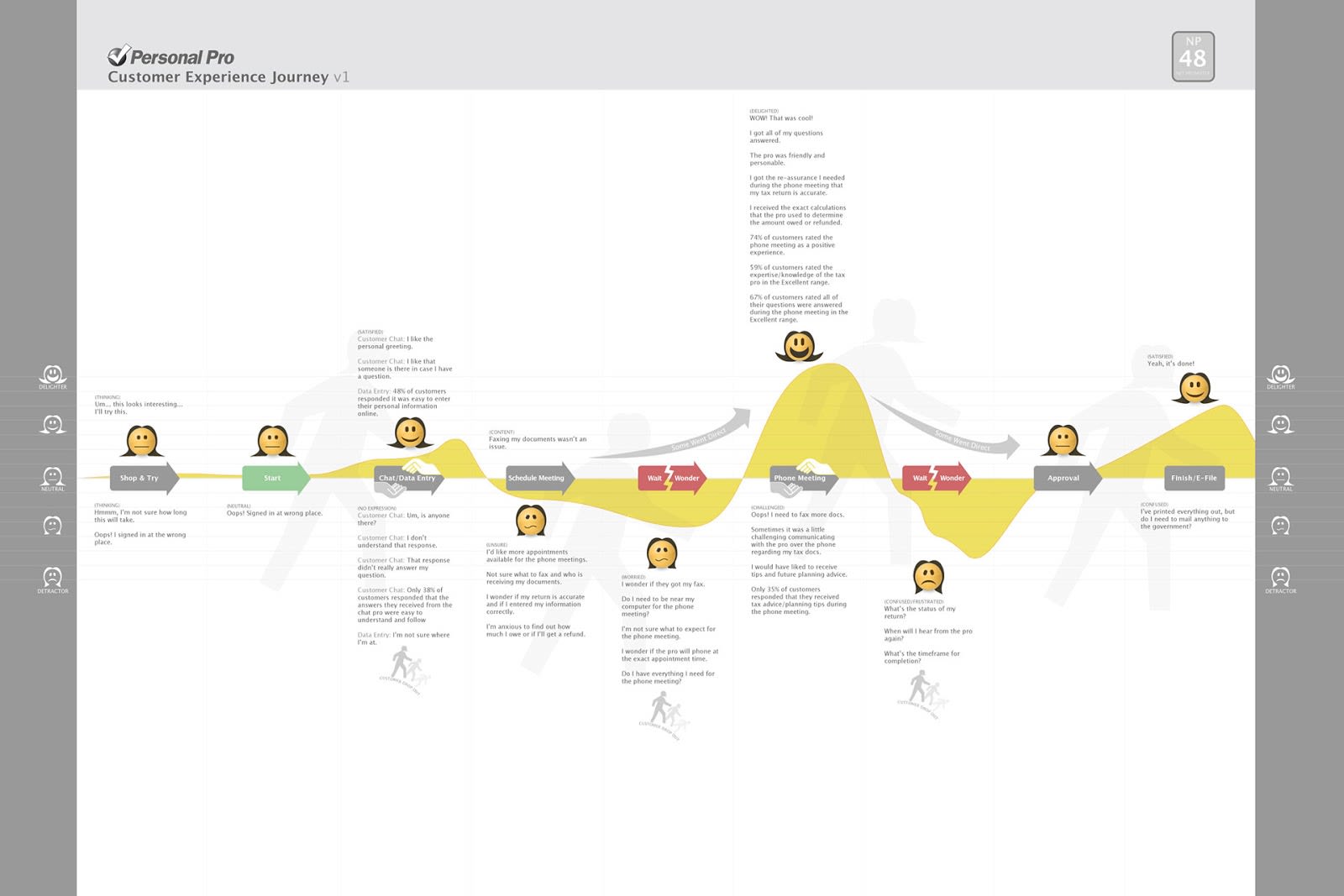
TurboTax’s customer journey analytics exercise starts when someone enters the website and is in the consideration phase through to the completion of the tax filing.
This customer journey map is great because it allows the team to see each customer pain point experienced and, therefore, address these pain points to make the customer experience smoother and more satisfactory.
Ecommerce Customer Journey Map Examples
The Ecommerce space is highly competitive in almost every niche these days. To maximize profit margins while keeping pricing competitive, it’s important to convert as many shoppers that visit your site as possible.
Also Read: Customer Journey Template
In addition to converting first-time customers at high rates, it’s important to have up-sell and cross-sell touchpoints in your customer journey as well. This increases the lifetime value of your customers and drives up the ROI against your acquisition costs.
Customer journey mapping is a vital exercise that can help E-commerce businesses skyrocket conversion rates from all online shoppers and achieve higher customer success.
1. Columbia Road
E-commerce agency, Columbia Road, created this map template for a fictitious online grocery shop. Here the agency demonstrates the core activities, goals, touchpoints, and experiences that a customer will go through during the decision-making process to place an order.
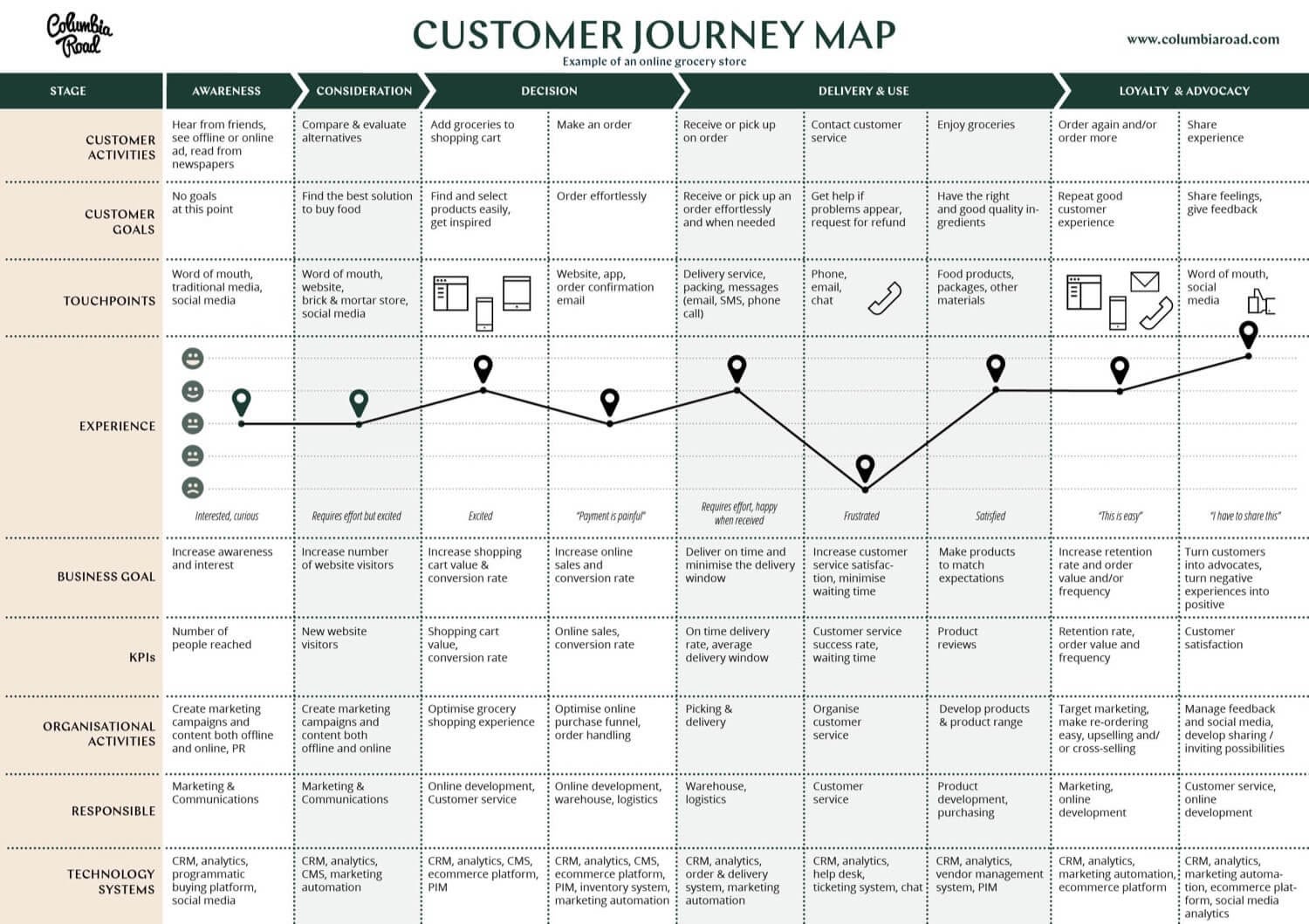
In this customer journey mapping exercise, the Columbia Road team went one step further than others by also including Key Performance Indicators (KPIs) and which department is responsible for ensuring a customer has the best experience possible at each stage within the user journey.
Including KPIs is important because it lets you know if your customer journey map template is effective or if it needs to be adjusted to better serve your shoppers.
2. Amazon
Amazon is one of the largest E-commerce shops in the world, with its own technology and custom systems in place for moving a customer through the sales journey. Its customer journey map is one of the most complex around and would take most people days to read through and understand each customer journey stage.
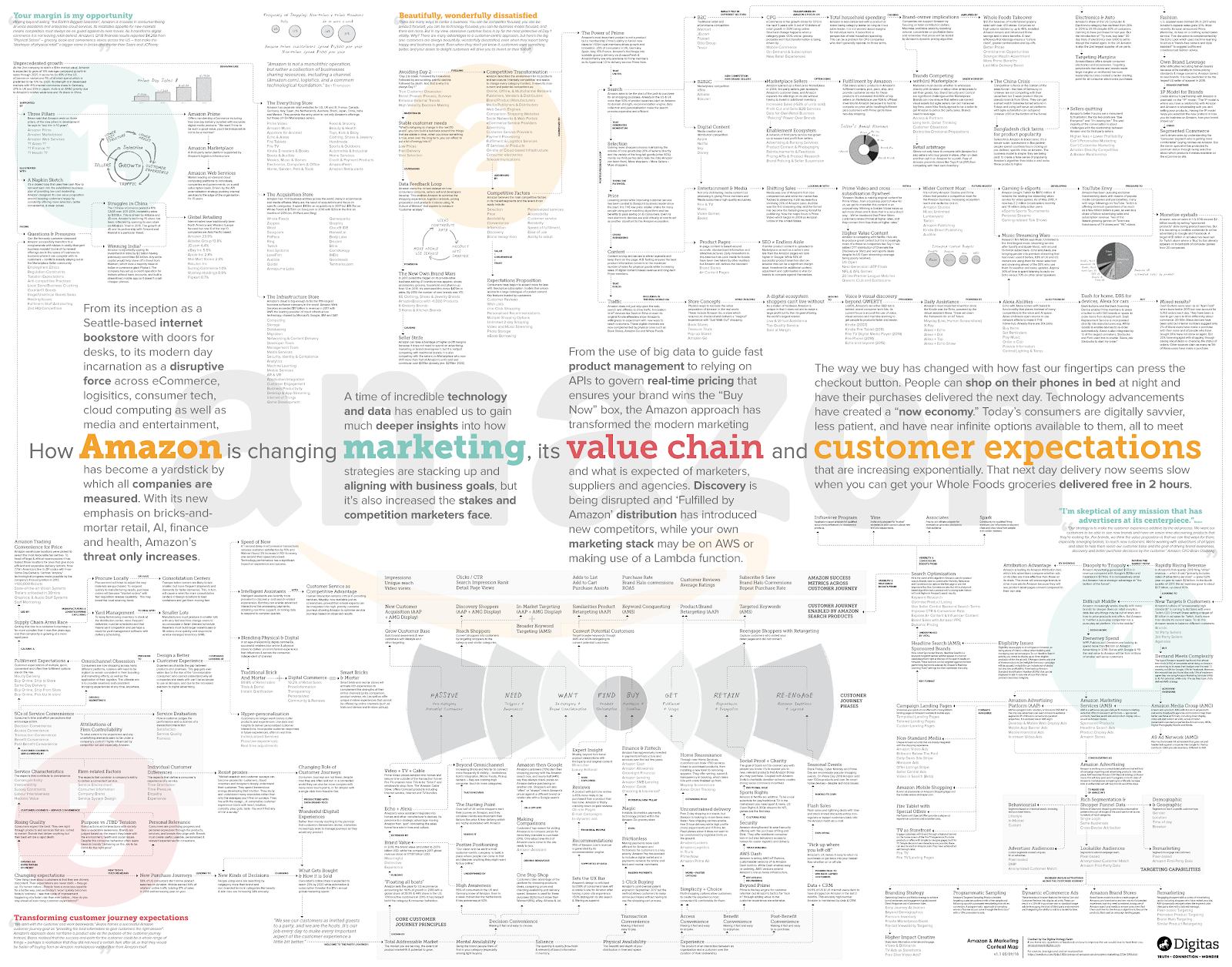
The good news is that the map can be broken down into several more digestible parts for analysis.
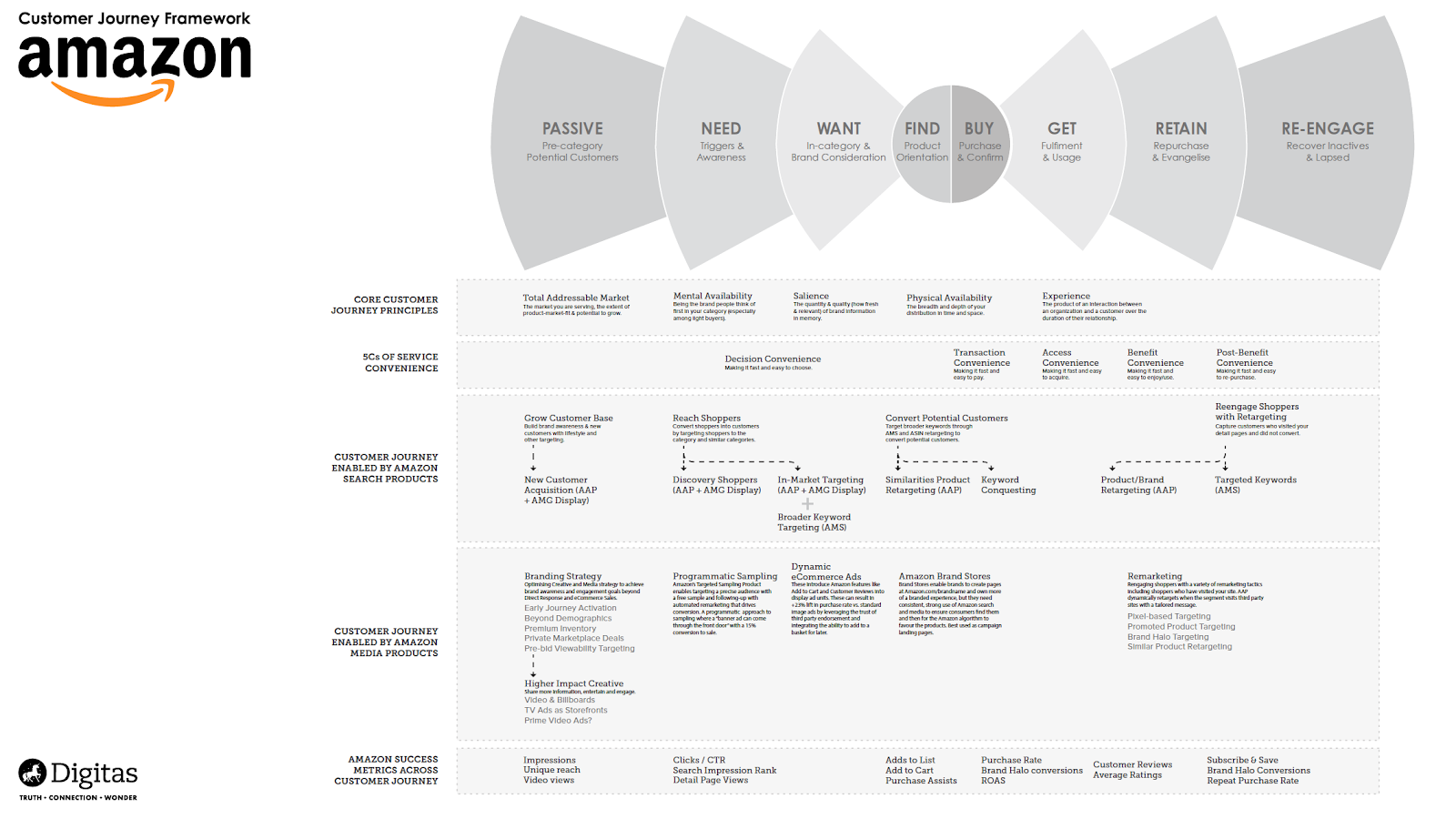
Here we can see Amazon’s customer conversion funnel and how the customer journey is enabled by its own products that push users through the sales funnel to maximize customer engagement.
Most interesting here is how Amazon includes its success metrics for each stage of the customer journey. These are the same success metrics that just about every E-commerce shop should be monitoring:
- Impressions
- Reach
- CTR
- Add to list
- Add to cart
- Purchase assists
- Conversion rate
- ROAS
- Reviews
- Subscriptions
- Repeat purchase rates
When conducting your customer journey mapping exercise, be sure to include these key metrics to monitor your success and gain deeper insight into the overall customer experience.
3. A More Common Scenario
If looking at the Amazon customer journey map feels overwhelming to you know that you’re not alone. Most E-commerce businesses will have a much less complicated customer journey to map out.
Here's a customer journey map template for the checkout process for online shops.
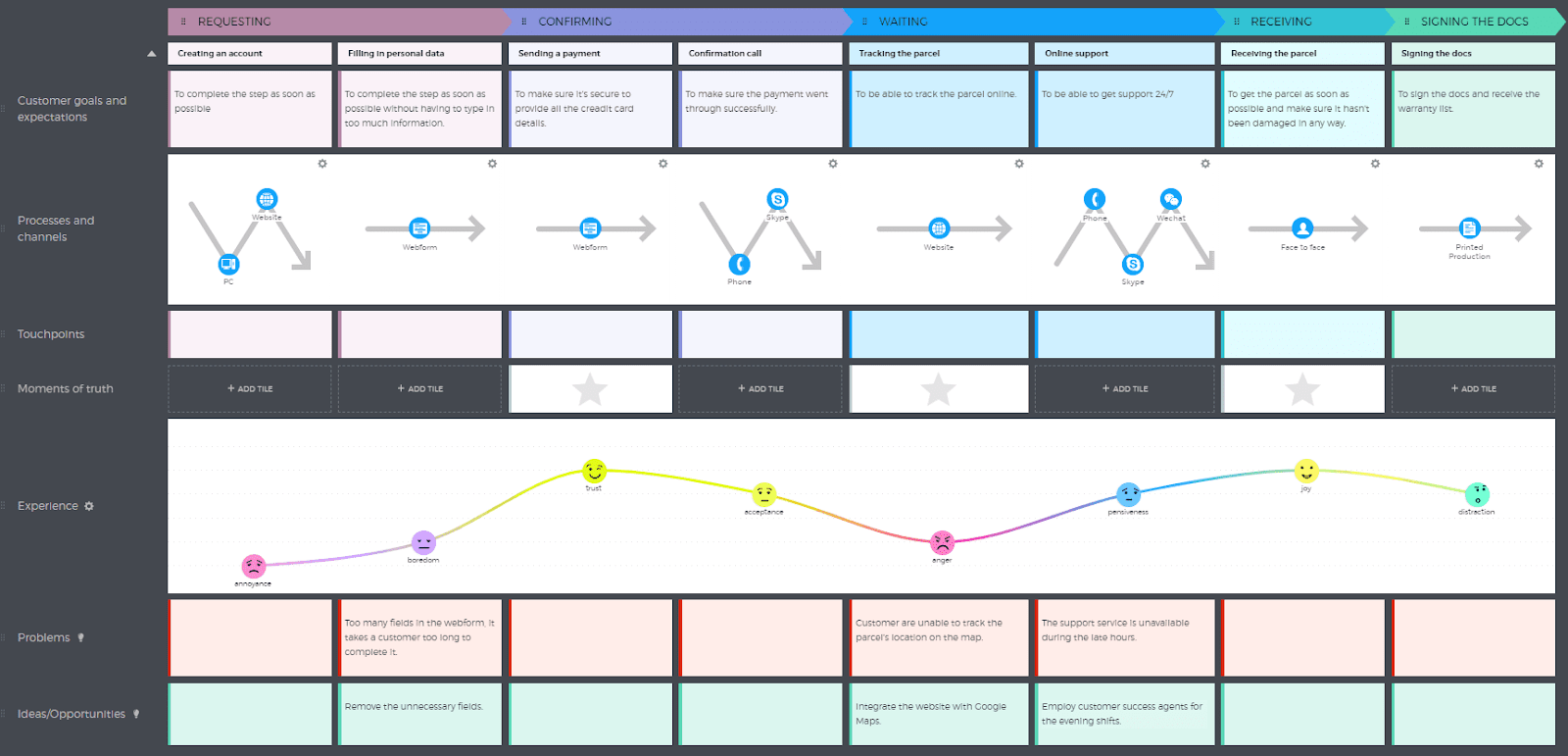
For instance, you see the most important stages of the checkout process, including the technology involved, common customer frustrations, and space to include solutions to make the process smoother.
For example, if a customer finds creating an account to be a barrier to checkout in the very first step - then offering a guest checkout option would be one solution for improving the customer experience.
Start your E-commerce customer journey mapping exercise using the above customer journey mapping template as an outline and then customize it for your own needs.
(If this isn't a good fit for your company, check out these other customer journey templates.)
B2B Customer Journey Map Examples (SaaS)
In the B2B customer journey, the sales cycle can vary significantly based on price point and the buy-in from stakeholders needed to make a business purchase.
1. Excel
When it comes to a B2B SaaS purchase for something reasonably inexpensive like Hootsuite’s social media management platform or the MailChimp email marketing platform, most of the customer journey will happen digitally with minimal to no involvement from a sales representative.
In this case, customer journey maps might be made using a simple Excel spreadsheet.
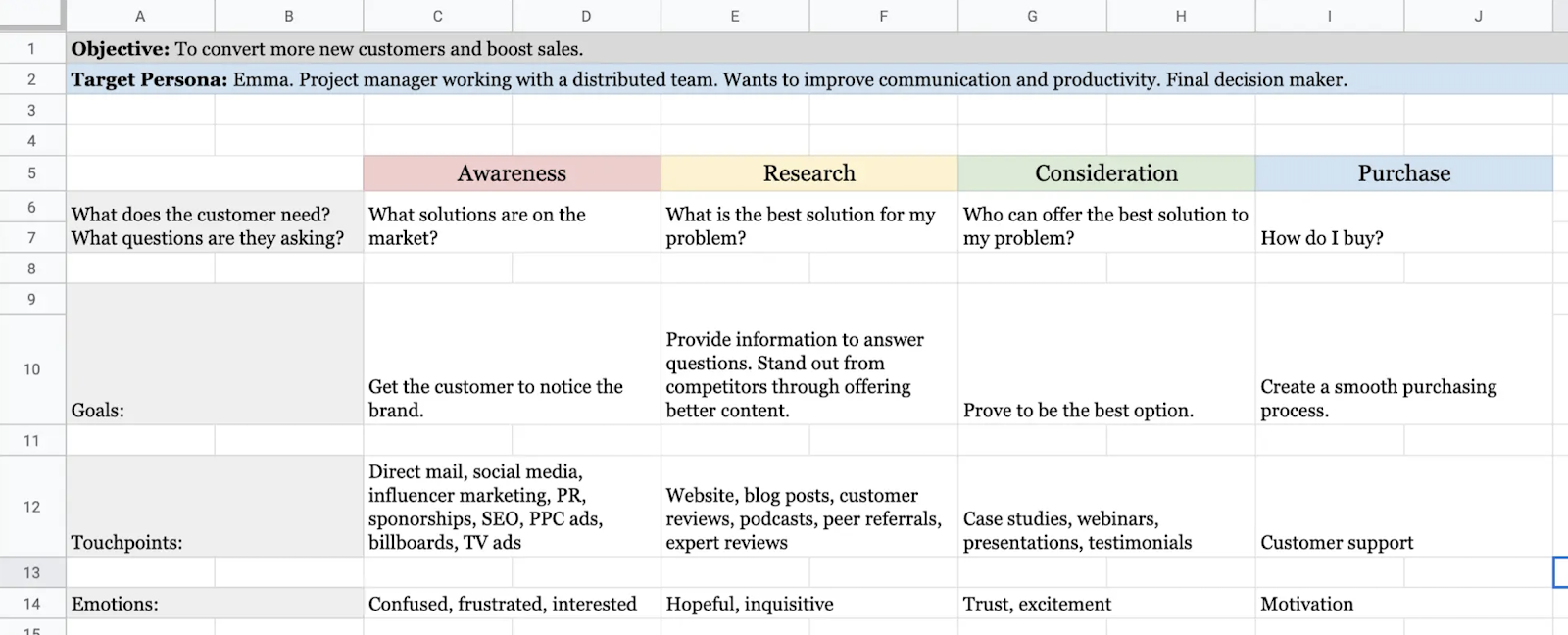
Because there are few high barriers to conversion, the customer sales journey can happen quickly and easily as long as the right digital touchpoints are in place.
The journey map example above shows that touchpoints can all be online assets from social media for awareness, to blog posts for research, to case studies or webinars for consideration. Finally, there might be a personal touchpoint at the very end if someone has a question right before or after purchasing.
If your customers go from Awareness to Purchase (or even Free Trial purchase) quickly, a simple user journey mapping might work for you.
2. HubSpot
If a B2B SaaS company has a longer sales cycle with a more highly considered product or service, the customer journey map should be more complex and done differently.
Below is an example from HubSpot. The first part of their customer journey map includes the various stages of the journey throughout each customer touchpoint:
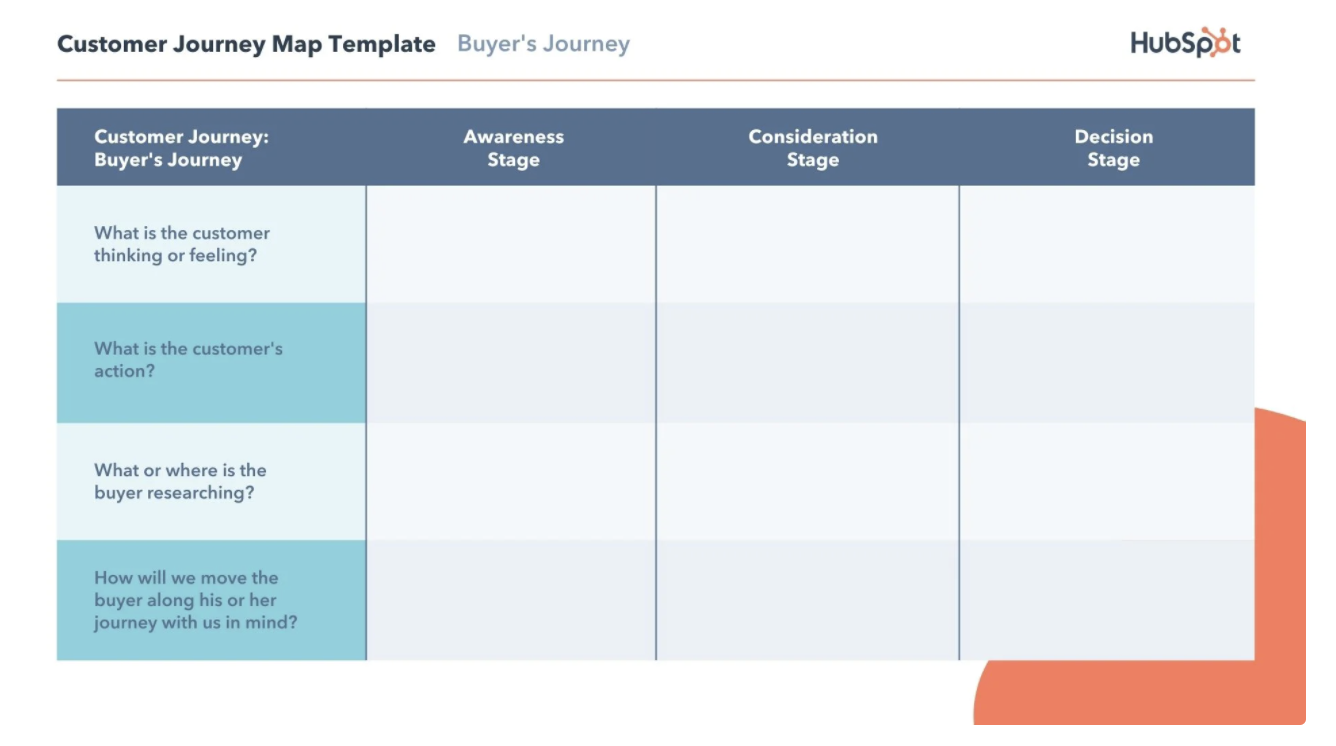
Because this is an example of a journey with a longer sales cycle, it also breaks down the stages into substages to dig further into the mindset of a potential customer.

Under the Awareness Stage would be the Stranger. Under the Consideration Stage would be the Subscriber/Lead and MQL (Marketing Qualified Lead). And under the Decision Stage would be the Opportunity and the Deal Closed/Handoff.
As a customer moves from, say, Subscriber to MQL in the Consideration Stage, they will experience different emotions and require different touchpoints to move through the sales funnel.
For example, a blog subscriber or newsletter subscriber might not even be able to afford your product or service, so it wouldn’t make sense to assign them a sales rep and waste that rep’s time.
However, once a subscriber becomes an MQL, and you know they fit your customer profile you can start treating this person as a real potential customer by dedicating more time and resources.
This also makes for a more relevant experience from your customer’s perspective. No one likes to be hassled to buy a product they can't afford.
In the overall customer journey, the subscriber and the MQL are both still in the Consideration Stage but they should be treated in a different way which is why it’s important to break the journey down into smaller stages if you have a longer sales cycle.
Optimize for Conversion & ROAS Now! Explore Woopra in a demo and enjoy a 2-week free trial: https://www.woopra.com/demo
What Makes a Good Customer Journey Map
Above we walked through several interesting examples of customer journey maps and discussed the pros and cons. Now, as you get ready to create your own map, let’s talk about key elements to keep in mind for best practices.
1. It Should Be Based on Market Research Plus Real Customer Data
According to a study from Ascend2 in partnership with Ansira, enterprise marketers are using customer feedback surveys (53%) and customer journey marketing research (47%) to build journey maps.
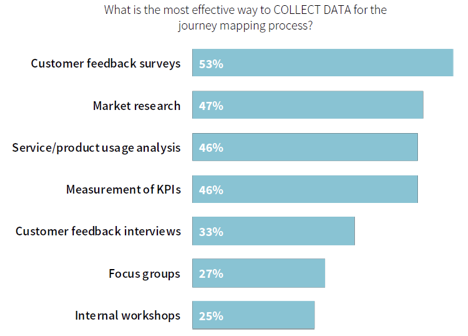
This is a great combination because it includes work based on theory as well as the real-world experiences of shoppers. And having this mix is critical for constructing effective journey maps and ultimately optimizing the customer experience.
Why is this combination key?
Customers don’t always know what they want or what they would prefer if they have never experienced a new product or feature before.
Therefore, it’s up to the business to continuously innovate and present ideas to shoppers. These new products and features should be workshopped based on a customer persona and user research.
Then, once the product or new feature is created, to make it as beneficial to the user as possible, feedback should be collected so improvements can be made.
Because customer journey maps need to take into account the thoughts and actions of users, compiling a document that includes a combination of market research and customer feedback surveys is the best way to get the data you need to make an effective journey map for your ideal buyer persona.
2. It Expands Beyond Your Marketing Funnel
A common pitfall for many companies when customer journey mapping is making a storyboard of the marketing funnel or marketing plan.
The marketing funnel is a good basis for creating a skeleton of the marketing portion of experience maps, but the user journey map should go well beyond marketing.
What does this mean?
The marketing funnel can be broken down into customer journey stages, just like your customer’s journey. It starts with awareness with your target audience and ends with a purchase from your ideal customer persona in the most basic sense (we often like to take this beyond purchase to gaining a loyal customer and getting a repeat purchase).
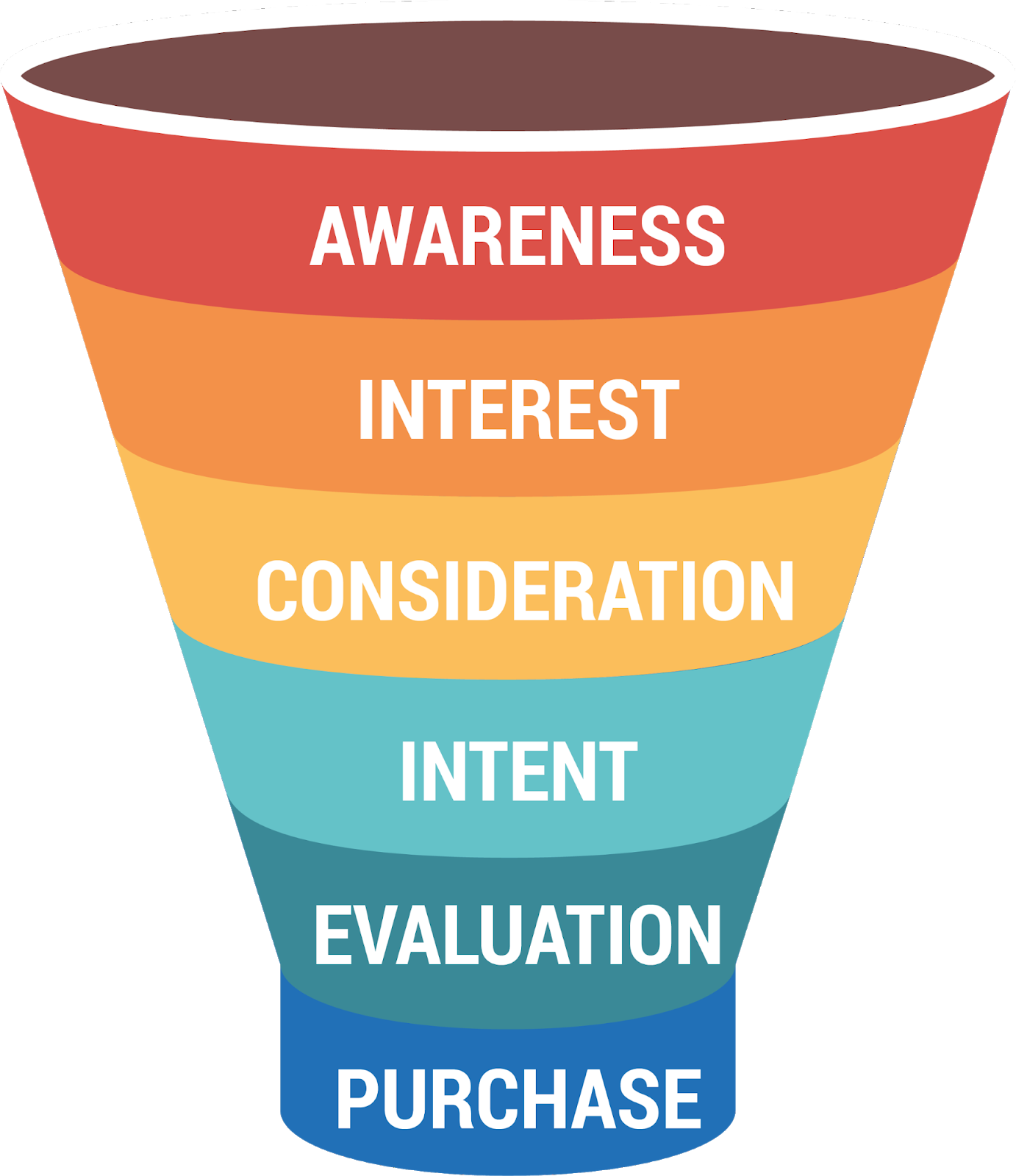
This means in the awareness stage of your marketing funnel you may talk about social media, Google Ads, and other forms of awareness building.
Then in the interest section, you may discuss email marketing, webinars, and other forms of content that increase interest. And in the consideration phase, you may talk about the UX design of your website, sales demonstrations, customer service, and so on.
A good marketing funnel will detail basic activities that should be carried out at each stage of the funnel for your user persona.
The Customer journey maps goes well beyond these basic activities and also lists out what a customer is thinking, feeling, and doing at each stage of the marketing funnel.
Think of it as a marketing funnel on steroids! It’s a much stronger and more powerful document than just your basic marketing funnel or marketing plan.
Additionally, any customer experience mapping needs to go beyond the marketing funnel. It should include the entire user experience with the product or service, each step in the sales cycle, and the touchpoints a person may routinely have with customer service.
3. It Includes KPIs
Good customer journey maps will include the various stages of the sales and marketing cycle as well as the thoughts, feelings, and actions of the user at each stage. Great customer journey maps will include KPIs for each stage.
Including KPIs is important so that the map can be evaluated by each customer touch point and adjusted when necessary.
Also, note that a customer journey map isn’t a document that is set in stone. It should be updated when new information is learned about:
- Customer behavior
- Customer needs
- Customer goals
- Customer expectations
- Customer satisfaction
- Customer support
- Customer service
It should also be evaluated and adjusted if overall sales and marketing goals are not being met.
Because the world is always evolving, so is the entire customer journey.
Whether you’re using a basic platform like Google Analytics or something more advanced like Woopra that’s specifically designed with the customer journey in mind, it should be capable of tracking all essential KPIs.
Get Started Creating Your Customer Journey Map
There's no better time to start laying the foundation for your customer journey mapping process than today.
By creating a visual representation of the buying process, you’ll gain valuable insight into the customer experience and reasons why customers do and don’t buy from you.
Once you’ve identified customer pain points you can make improvements at the necessary customer journey touchpoints, as well as optimize your customer service blueprint to position your business for sales success.
Remember, the whole goal is to put yourself in your customer’s shoes to create the best possible shopping experience for customer retention!



